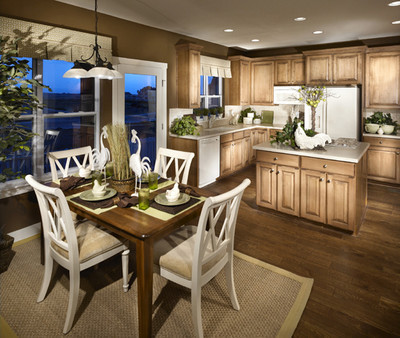DESIGN EVOLUTION
The first kitchen was probably nothing more than a fire pit created by our ancient brothers and sisters who gathered around it while feasting on freshly caught woolly mammoth or saber-toothed cat. Today's kitchens are much more sophisticated, with over-the-top designs that include sleek appliances, furniturelike cabinetry and natural stone countertops. So instead of woolly mammoth and saber-toothed cat on a stick, dinner is more likely ostrich burgers and domestic grown filet of alligator prepared on the indoor grill.
Since those early days, the kitchen has evolved to become the most important room in the house. According to Verna Lutz, a senior design studio counselor for Beazer Homes, kitchens aren't just kitchens anymore, they have become great rooms.
"There is a philosophy that a lonely cook is an unhappy cook," said Lutz, "so kitchens are now part of a breakfast nook or family room with large pantries. The first thing my customers want to discuss after agreeing to buy a home is the kitchen. They want to personalize everything including flooring, lighting, plumbing and cabinets. They want chef-grade appliances, walk-in pantries, solid-surface countertops and center islands. They want their dream kitchen."
The dream kitchen can be many things and, according to Lutz, the two most popular things to consider are countertops and appliances.
"Most people want to upgrade their countertops with granite or Silestone," Lutz said. "Silestone is a manmade material. It uses natural stone, like quartz, and then resins and antimicrobial features are infused to make it hard and germproof. Next comes appliances and the first upgrade is always the refrigerator with the most popular being the French two-door model that has the freezer on the bottom. Remember, this is not just a kitchen anymore. It's an integral part of the home."
This is a far cry from the early settler's home where the kitchen was purely utilitarian. Until the 18th century, when food was heated on an open fire, the kitchen was kept separate from the main house. By the turn of the 20th century it followed indoor plumbing into the main home, but was located in areas primarily used by servants. It started to evolve in the 1930s when electric stoves became available to the masses, followed by small appliances like toasters and blenders.
Kent Goff, vice president of planning and design for Beazer Homes, said it wasn't until the mid-1950s that kitchens began showing connectivity to other parts of the house.
"It started with simple features like the pass-through opening that linked the kitchen to the dining room," he explained. "Then more walls came down during the '60s and the kitchen took on a more important role in the busy lives of families. By the '80s, it had emerged as the central hub and today is considered the hardest working space in the home."
Charise Diamond, owner of Bosch Kitchen Store in Las Vegas, can attest to that. Her customers use the kitchen as a focal point for entertaining.
"People create large parties around the kitchen," she said. "The host and hostess will have friends bring food to prepare in the kitchen or just bring new dishes for others to try. And today's modern kitchen faces out into the great room or family room so the main person in the kitchen can participate in all the conversation and activities. This has opened a wider panorama for interaction with family and guests making the kitchen much more user-friendly."
Diamond said homeowners are requesting kitchens with stoves that have double ovens, warming drawers, kitchen cabinets with glide-out shelving and are even building pizza ovens on their patios adjacent to their kitchen's sliding doors.
"The Food Network and 'Iron Chef' have brought people back into the kitchen and if they see it on television, they want it in their home," Diamond said. "One of my big sellers is bread machines. And not only bread machines, but people are buying and storing their own grains, too."
The future has the kitchen becoming more of an entertainment center as it adapts to changing lifestyles with nontraditional features like home office workstations, gadget charging nooks and hidden message centers. Conversely, typical kitchen elements are relocating to others parts of the home, such as a coffee nook in the master suite or a wet bar with storage and refrigeration for the media room.






















